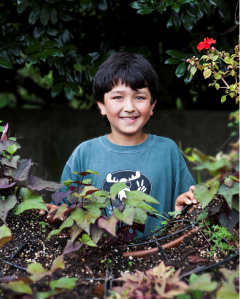Kid-to-Kid Vegetable Gardening Tips
Posted in Exhibitions, Learning Experiences, The Edible Garden on August 26 2010, by Plant Talk
9-Year-Old Everett Sanderson Offers 9 Tips to Get Growing
 |
Elizabeth Fisher is Associate Manager for Education Marketing and Public Relations. |
 Everett Sanderson is a talented soon-to-be fifth grader who has spent most of his nine summers gardening in the Ruth Rea Howell Family Garden, helping his mom, Han-Yu Hung, who is Garden Coordinator of the Children’s Gardening Program. In the Family Garden, kids work hands-on growing fruits and vegetables, learning that food, fun, health, and teamwork are connected. This year their garden plots have been in the spotlight as part of The Edible Garden.
Everett Sanderson is a talented soon-to-be fifth grader who has spent most of his nine summers gardening in the Ruth Rea Howell Family Garden, helping his mom, Han-Yu Hung, who is Garden Coordinator of the Children’s Gardening Program. In the Family Garden, kids work hands-on growing fruits and vegetables, learning that food, fun, health, and teamwork are connected. This year their garden plots have been in the spotlight as part of The Edible Garden.
Unlike most 9-year-olds, Everett is an accomplished gardener and a lover of veggies. Harvesting is what hooked him at first: “I realized that in order to harvest, you have to grow it, and in order to grow it, you have to plant it,” said Everett. Gardening also helped him to love eating vegetables: “If you can plant it, you have a better chance of liking it.”
Now a veteran of the Children’s Gardening Program, Everett, who lives in the Bronx, started gardening at age 3 as a “Garden Sprout” and is now a “Garden Crafter,” leading gardening lessons and hands-on activities.
He shares these helpful tips for kids to get their own gardens growing.
- Get used to critters: Some critters are good for your garden. Worms help the soil and composting and butterflies help pollinate the plants. Some bugs help by eating the bad bugs: spiders eat flies and ladybugs eat aphids. Everett warns that some pesky critters like snails, slugs, aphids, and caterpillars eat your plants.
- Use natural fertilizers: “We don’t use chemicals,” Everett explained, “so you can use organic—that means natural—stuff to help plants grow.” His recommended organic fertilizer is cornmeal (ground up corn). But he also says you can try some “really weird” fertilizers such as pigeon dung and dried animal blood.
- Get rid of contaminated leaves: Sometimes you’ll see little white or green spots on the under side of the leaf. The green spots are aphids and white are their eggs. Other times you’ll see holes in the leaves. Those are caterpillars. You need to remove the contaminated leaf so the whole plant doesn’t rot.
- Plants get thirsty: The hot summer sun can be a problem for plants if you don’t water well. Everett recommends watering your garden plants three times every other day, using one watering can in the morning and two toward evening.
- Know when to harvest: Knowing when to harvest means knowing your plants and using your observation skills. Here are hints about harvesting some delicious veggies:
- Carrots, radishes, and scallions are ready when you can see the top of the veggie popping out of the soil.
- Garlic and potatoes are ready to dig or pull up when the leaves are dry and turn all yellow.
- Corn is ready once you see silky tufts coming out of the stalk. “The hair means there’s corn there,” Everett offered.
- Tomatoes are ready to harvest when the color is right. Sun gold tomatoes turn from yellow to bright orange when they’re ready to pick. Regular tomatoes start out green and turn bright red when they’re ready.
- Compost to feed the soil: Composting is the process of breaking down plants so that you can reuse them to add nutrients into your garden’s soil. Have an adult help you create a compost bin. Put all rotten, old veggies and plants into the bin. Then you can add a couple of worms to decompose the veggie matter. “You don’t need to have worms,” Everett explains, “They just speed up the process.” You can stir up the compost every two weeks, or rotate it into different compartments if you want to add new plants.
- Choose plants that fit your skill level: Beginning gardeners should first plant veggies that require the least amount of time and energy. Some easy veggies are: radishes, beans, lettuce, and peas. Once you’ve mastered those, you can try some harder plants like scallions and potatoes, which can be tricky to plant because you have to make sure the correct part is right side up.
- Safety first: Always wear a hat and sunscreen to protect your skin from harmful UVA rays. Bring water to stay hydrated. Other helpful tips: Bees won’t sting you if you just stay still. Use trowels (little shovels) to help you dig under adult supervision. Gloves are optional as “you’re going to get dirty” anyway.
- Oh, yes! Get planting help from an adult: All plants need the same things: soil, water, and sunlight. Everett recommends getting help to plan and plant your garden from a grown-up such as a parent, teacher, or instructor from the Children’s Gardening Program. For kids who don’t have home gardens, Everett suggests asking their parents to start a community garden or an edible garden at school.
If you bring your family to the Family Garden during The Edible Garden, you may see Everett. He’d be happy to share his gardening tips with you and may also put you to work: “We get a bit of free labor out of the guests,” Everett admitted.

